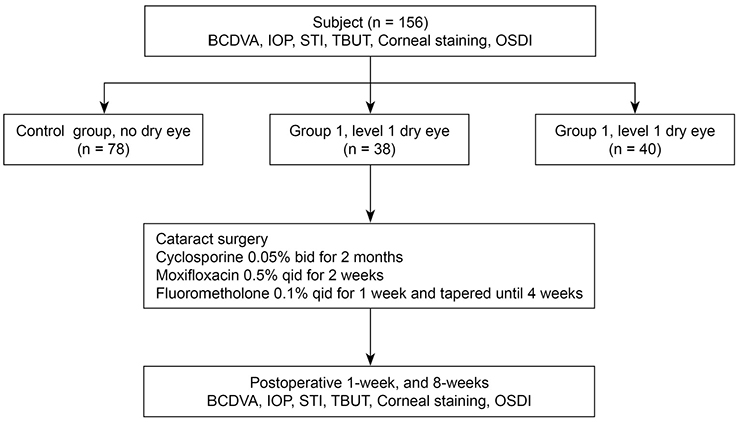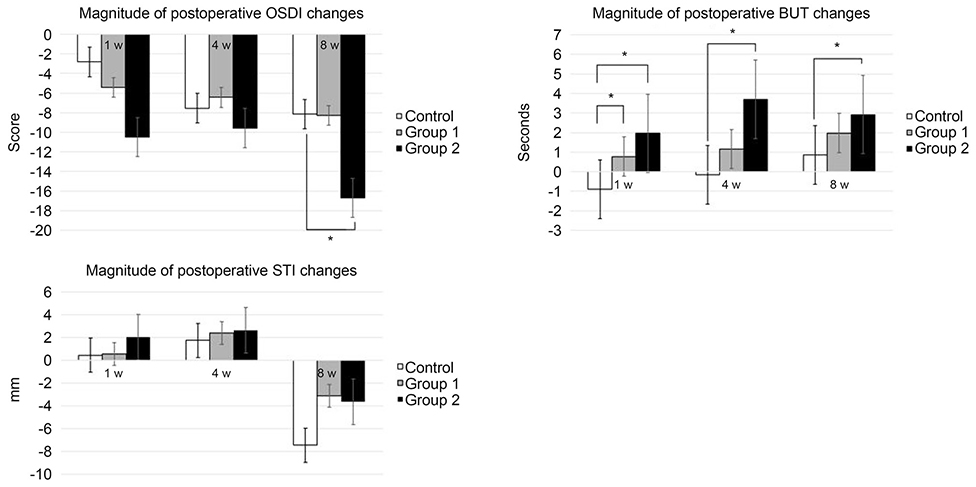J Korean Ophthalmol Soc.
2019 Sep;60(9):821-828. 10.3341/jkos.2019.60.9.821.
Effectiveness of Cyclosporine-steroid Treatment after Cataract Surgery according to Dry Eye Severity
- Affiliations
-
- 1Department of Ophthalmology, Pusan National University Hospital, Pusan National University School of Medicine, Busan, Korea. jongsool@pusan.ac.kr
- 2Department of Ophthalmology, Gyeongsang National University Changwon Hospital, Gyeongsang National University School of Medicine, Changwon, Korea.
- 3Department of Ophthalmology, Pusan National University Yangsan Hospital, Pusan National University School of Medicine, Yangsan, Korea.
- 4Department of Ophthalmology, Dongguk University Ilsan Hospital, Dongguk University College of Medicine, Goyang, Korea.
- KMID: 2459125
- DOI: http://doi.org/10.3341/jkos.2019.60.9.821
Abstract
- PURPOSE
To evaluate the effectiveness of topically administered 0.05% cyclosporine combined with a topical steroid in the early postoperative period after cataract surgery, and to compare the therapeutic efficacy according to the severity of dry eye.
METHODS
One hundred and fifty-six patients who underwent unilateral cataract surgery and received topical cyclosporine 0.05% for 8 weeks combined with a fluorometholone 0.1% steroid for 4-weeks were classified into three groups according to preoperative dry eye level: the control group, non-dry eye (n = 78); group 1, level I dry eye (n = 38); and group 2, level II dry eye (n = 40). The best-corrected distance visual acuity, intraocular pressure, dry eye symptom questionnaire (ocular surface disease index), tear film break-up time (TBUT), and Schirmer test-I (STI) were evaluated.
RESULTS
The preoperative score of dry eye symptoms improved significantly at one week postoperatively and continued to improve until postoperative 8-weeks in all groups, especially in group 2 compared with the control. Groups 1 and 2 showed significant improvement in the TBUT at one week, four weeks, and eight weeks postoperatively, compared to eight weeks postoperatively in the control; Group 2, especially, showed significant improvement in TBUT. There was no difference in STI value after cyclosporine-steroid treatment in the control group; however, a significant difference was observed at four weeks postoperatively in dry eyes. No significant differences in STI results were observed among the three groups.
CONCLUSIONS
Use of topical cyclosporine 0.05% combined with a topical fluorometholone 0.1% steroid after cataract surgery is more effective in dry eyes level II than in non-dry eyes, especially those with TBUT and dry eye symptoms at eight weeks postoperatively.
Keyword
MeSH Terms
Figure
Reference
-
1. Khanal S, Tomlinson A, Esakowitz L, et al. Changes in corneal sensitivity and tear physiology after phacoemulsification. Ophthalmic Physiol Opt. 2008; 28:127–134.
Article2. Kohlhaas M. Corneal sensation after cataract and refractive surgery. J Cataract Refract Surg. 1998; 24:1399–1409.
Article3. Li XM, Hu L, Hu J, Wang W. Investigation of dry eye disease and analysis of the pathogenic factors in patients after cataract surgery. Cornea. 2007; 26(9 Suppl 1):S16–S20.
Article4. Donnenfeld ED, Solomon R, Roberts CW, et al. Cyclosporine 0.05% to improve visual outcomes after multifocal intraocular lens implantation. J Cataract Refract Surg. 2010; 36:1095–1100.
Article5. Chung YW, Oh TH, Chung SK. The effect of topical cyclosporine 0.05% on dry eye after cataract surgery. Korean J Ophthalmol. 2013; 27:167–171.
Article6. Sahli E, Hoşal BM, Zilelioğlu G, et al. The effect of topical cyclosporine A on clinical findings and cytological grade of the disease in patients with dry eye. Cornea. 2010; 29:1412–1416.
Article7. Baiza-Durán L, Medrano-Palafox J, Hernández-Quintela E, et al. A comparative clinical trial of the efficacy of two different aqueous solutions of cyclosporine for the treatment of moderate-to-severe dry eye syndrome. Br J Ophthalmol. 2010; 94:1312–1315.8. Report of the Definition and Classification Subcommittee of the International Dry Eye WorkShop. The definition and classification of dry eye disease. Ocul Surf. 2007; 5:75–92.9. Schiffman RM, Christianson MD, Jacobsen G, et al. Reliability and validity of the Ocular Surface Disease Index. Arch Ophthalmol. 2000; 118:615–621.
Article10. Lemp MA. Report of the National Eye Institute/Industry workshop on Clinical Trials in Dry Eyes. CLAO J. 1995; 21:221–232.11. Kasetsuwan N, Satitpitakul V, Changul T, Jariyakosol S. Incidence and pattern of dry eye after cataract surgery. PLoS one. 2013; 8:e78657.
Article12. Liu Z, Luo L, Zhang Z, et al. Tear film changes after phacoemulsification. Zhonghua Yan Ke Za Zhi. 2002; 38:274–277.13. Cho YK, Kim MS. Dry eye after cataract surgery and associated intraoperative risk factors. Korean J Ophthalmol. 2009; 23:65–73.
Article14. Müller LJ, Vrensen GF, Pels L, et al. Architecture of human corneal nerves. Invest Ophthalmol Vis Sci. 1997; 38:985–994.15. Roberts CW, Elie ER. Dry eye symptoms following cataract surgery. Insight. 2007; 32:14–21.16. Wilson WS, Duncan AJ, Jay JL. Effect of benzalkonium chloride on the stability of the precorneal tear film in rabbit and man. Br J Ophthalmol. 1975; 59:667–669.
Article17. Zabel RW, Mintsioulis G, MacDonald IM, et al. Corneal toxic changes after cataract extraction. Can J Ophthalmol. 1989; 24:311–316.18. Al-Aqaba MA, Fares U, Suleman H, et al. Architecture and distribution of human corneal nerves. Br J Ophthalmol. 2010; 94:784–789.
Article19. Hamada S, Moore TCB, Moore JE, et al. Assessment of the effect of cyclosporine A 0.05% emulsion on the ocular surface and corneal sensation following cataract surgery. Cont Lens Anterior Eye. 2016; 39:15–19.20. Choi W, Yoon KC. Effect of 0.1% sodium hyaluronate and 0.05% cyclosporine on tear film parameters after cataract surgery. J Korean Ophthalmol Soc. 2011; 52:800–806.
Article21. Peyman GA, Sanders DR, Batlle JF, et al. Cyclosporine 0.05% ophthalmic preparation to aid recovery from loss of corneal sensitivity after LASIK. J Refract Surg. 2008; 24:337–343.
Article22. Sall K, Stevenson OD, Mundorf TK, Reis BL. Two multicenter, randomized studies of the efficacy and safety of cyclosporine ophthalmic emulsion in moderate to severe dry eye disease. CsA Phase 3 Study Group. Ophthalmology. 2000; 107:631–639.23. Lee HS, Jang JY, Lee SH, et al. Clinical effectiveness of topical cyclosporine a 0.05% after laser epithelial keratomileusis. Cornea. 2013; 32:e150–e155.
Article24. Ursea R, Purcell TL, Tan BU, et al. The effect of cyclosporine A (Restasis) on recovery of visual acuity following LASIK. J Refract Surg. 2008; 24:473–476.
Article25. Sheppard JD, Scoper SV, Samudre S. Topical loteprednol pretreatment reduces cyclosporine stinging in chronic dry eye disease. J Ocul Pharmacol Ther. 2011; 27:23–27.
Article26. Cho P, Yap M. Schirmer test. II. A clinical study of its repeatability. Optom Vis Sci. 1993; 70:157–159.
Article27. Massingale ML, Li X, Vallabhajosyula M, et al. Analysis of inflammatory cytokines in the tears of dry eye patients. Cornea. 2009; 28:1023–1027.
Article28. Byun YJ, Kim TI, Kwon SM, et al. Efficacy of combined 0.05% cyclosporine and 1% methylprednisolone treatment for chronic dry eye. Cornea. 2012; 31:509–513.
Article29. Toker E, Asfuroğlu E. Corneal and conjunctival sensitivity in patients with dry eye: the effect of topical cyclosporine therapy. Cornea. 2010; 29:133–140.
Article
- Full Text Links
- Actions
-
Cited
- CITED
-
- Close
- Share
- Similar articles
-
- The Effect of Topical Cyclosporine 0.05% on Dry Eye after Cataract Surgery
- Comparison of the Effects of 0.05% and 0.1% Cyclosporine for Dry Eye Syndrome Patients after Cataract Surgery
- Effect of 0.1% Sodium Hyaluronate and 0.05% Cyclosporine on Tear Film Parameters after Cataract Surgery
- Effects of Cyclosporine 0.05% Ophthalmic Emulsion to Improve Reduction of Tear Production after Cataract Surgery
- Assessment of the Compliance with 0.1% Cyclosporine A in Dry-Eye Patients with Sjögren's Syndrome






